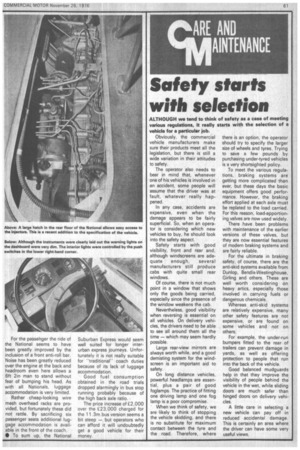Safety starts with selection
Page 63

If you've noticed an error in this article please click here to report it so we can fix it.
ALTHOUGH we tend to think of safety as a case of meeting with the selection of a various regulations, it really starts vehicle for a particular job. Obviously, the commercial vehicle manufacturers make sure their products meet all the legislation, but there is still a wide variation in their attitudes to safety.
The operator also needs to bear in mind that, whenever one of his vehicles is involved in an accident, some people will assume that the driver was at fault, whatever really happened.
In any case, accidents are expensive, even when the damage appears to be fairly superficial. So, when an operator is considering which new vehicles to buy, he should look into the safety aspect.
Safety starts with good visibility, front and rear and, although windscreens are ade quate enough, several manufacturers still produce cabs with quite small rear windows.
Of course, there is not much point in a window that shows only the goods being carried, especially since the presence of the window weakens the cab.
Nevertheless, good visibility when reversing is essential on all vehicles. On delivery vehicles, the drovers need to be able to see all around them all the time — which may seem hardly possible.
Large rear-view mirrors are always worth while, and a good demisting system for the windscreen is an important aid to safety.
On long distance vehicles, powerful headlamps are essen tial, plus a pair of good foglamps. The practice of fitting one driving lamp and one fog lamp is a poor compromise.
• When we think of safety, we are likely to think of stopping the vehicle skidding, and there is no substitute for maximum contact between the tyre and the road. Therefore, where there is an option, the operator should try to specify the larger size of wheels and tyres. Trying to save a few pounds by purchasing under-tyred vehicles is a very shortsighted policy.
To meet the various regulations, braking systems are getting more complicated than ever, but these days the basic equipment offers good performance. However, the braking effort applied at each axle must be replated to the load carried. For this reason, load-apportioning valves are now used widely.
There have been problems with maintenance of the earlier versions of these valves, but they are now essential features of modern braking systems and are fairly reliable.
For the ultimate in braking safety, of course, there are the anti-skid systems available from Dunlop, Bendix-Westinghouse, Girling and others. These are well worth considering on heavy artics, especially those involved in carrying fuels or dangerous chemicals.
Whereas anti-skid systems are relatively expensive, many other safety features are not expensive, or are found on some vehicles and not on others.
For example, the under-run bumpers fitted to the rear of trailers can prevent damage in yards, as well as offering protection to people that run into the back of the vehicle.
Good balanced mudguards help in that they improve the visibility of people behind the vehicle in the wet, while sliding doors are much safer than hinged doors on delivery vehicles.
A little care in selecting a new vehicle can pay off in reduced accidental damage. This is certainly an area where the driver can have some very useful views.








































































































